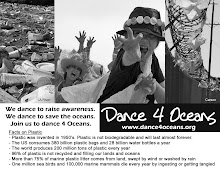Valentine’s Day is coming. It is one of the most romantic and exciting day of the year for all ages. However, there will be many “lost hearts” in the ocean.
Please read my blog from the last year right after Valentine’s Day. I picked up 16 hearts!
http://dance4oceans.blogspot.com/2010/02/happy-valentines-day-this-love-will.html

Estimates that 100,000 marine mammals and turtles and 1 million sea birds die every year from ingesting or becoming entangled in marine debris, including indigestible plastic that blocks stomachs. Sea turtles and other wildlife have been found starved to death with latex balloons blocking their stomachs. Even an infant sperm whale was found dead of starvation as a result of ingestion of an inflated Mylar balloon which had lodged in its intestines.

Mylar balloons are commonly bought as Valentine’s Day gifts. It’s made from metalized nylon (plastic) that is not biodegradable. They are filled with helium so that they float in the air. Plastic will stay on earth for hundreds of years. If you let go of the strings, they will travel far, and some may become entangled in power lines or trees, and other may land on the sea and create a serious entanglement hazard to marine animals.
Most of latex balloons are made from a natural substance and will biodegrade over time. The Balloon Council says that latex balloon release is safe as long as they are released with no strings or ribbons attached. (
http://www.theballooncouncil.org/myths-facts.html)
However, that is not true at all.
When balloon go to high altitude, they break into spaghetti-like pieces and retune to earth. That shape of broken balloons can look like sea jellies, which are a major source of food for many sea animals. Sea turtles, dolphins, whales, fish, and seabirds have been found with balloons in their stomachs. According to The Balloon Council, “regardless of the latex balloon’s ultimate form when it lands, it will decompose, forming a natural soil nutrient at the same rate as that of an oak leaf.” If this were true, it would take 6 months to a year for latex balloons to decompose! That is way long enough to harm animals in the ocean! Some study in North Carolina says that balloons exposed floating in seawater deteriorate much more slowly than those exposed in air. I have a few latex balloons attached on my “Plastic Trash Zombie” costumes since Oct. 2009, and they still keep their shape and elasticity, though they have become a little bit sticky.

Balloons bring people fantasy and dream-like feeling. They are festive and uplifting. While it is almost impossible to ban balloons, we can educate ourselves not to let go balloons. If we receive a floating big heart on this coming Valentine’s Day, let's graciously thank the sender. But after his/her sweet message is successfully delivered, pop each one of them with care and carefully depose them into a trash bag. Never release balloons in the air if you don’t want to let go your love.
By the way, The Balloon Council’s website shows this record to prove that balloon releases do not harm environment as much as other individual balloons do. I personally believe that this is pointless. Besides, they found 288 balloon pieces during one single beach cleanup! We have to do something, Mr. Balloon Council!
In one Florida-wide cleanup there were 288 balloons/balloon pieces found. Of these:
• 79 were water balloons (not used in balloon releases)
• 38 were too small to have been released
• 96 had strings/ribbon/thread attached (never used in a release)
• 2 were valved (never used in a qualified release)
• 3 were shaped (never used in a qualified release)
• 70 — less than 25 percent — might have been used in releases
Photos courtesy by Danielle Frechette (Northern Fulmar), the U.S. Fish & Wildlife Service (power line), Sara Bayles (burst balloon).



















